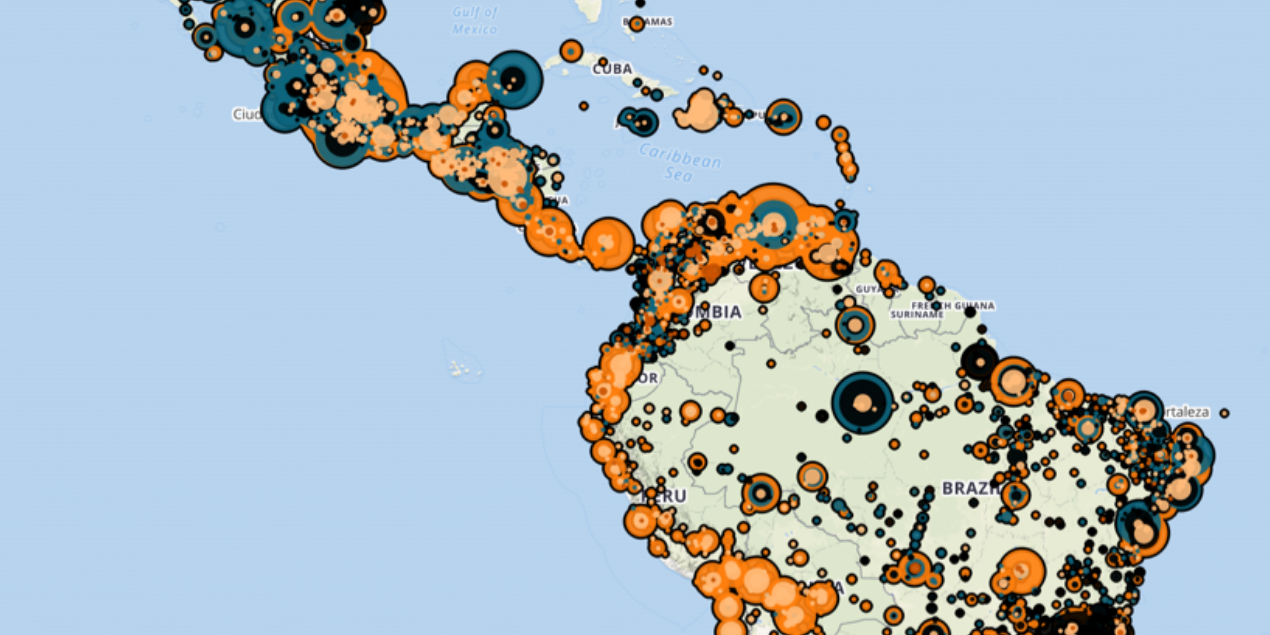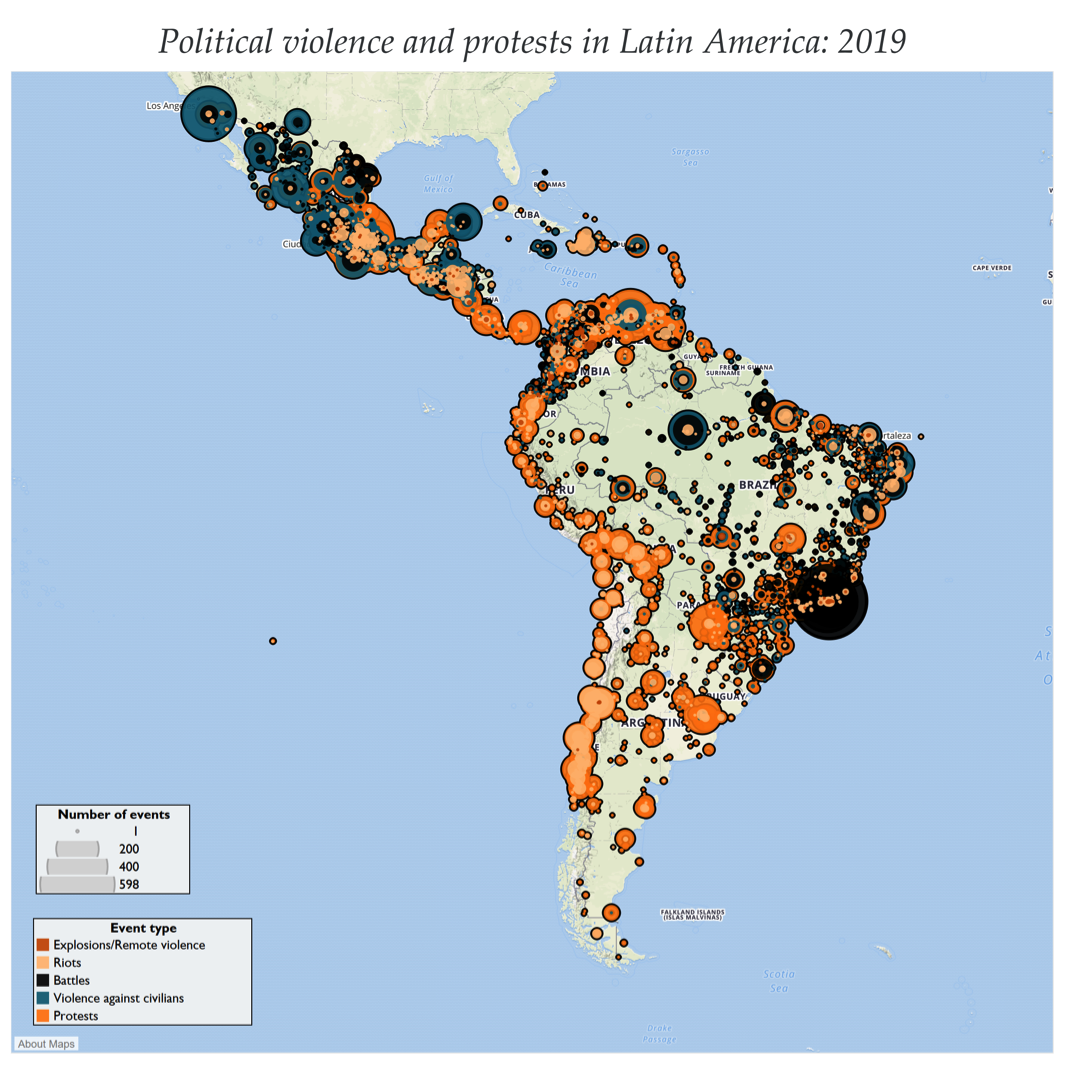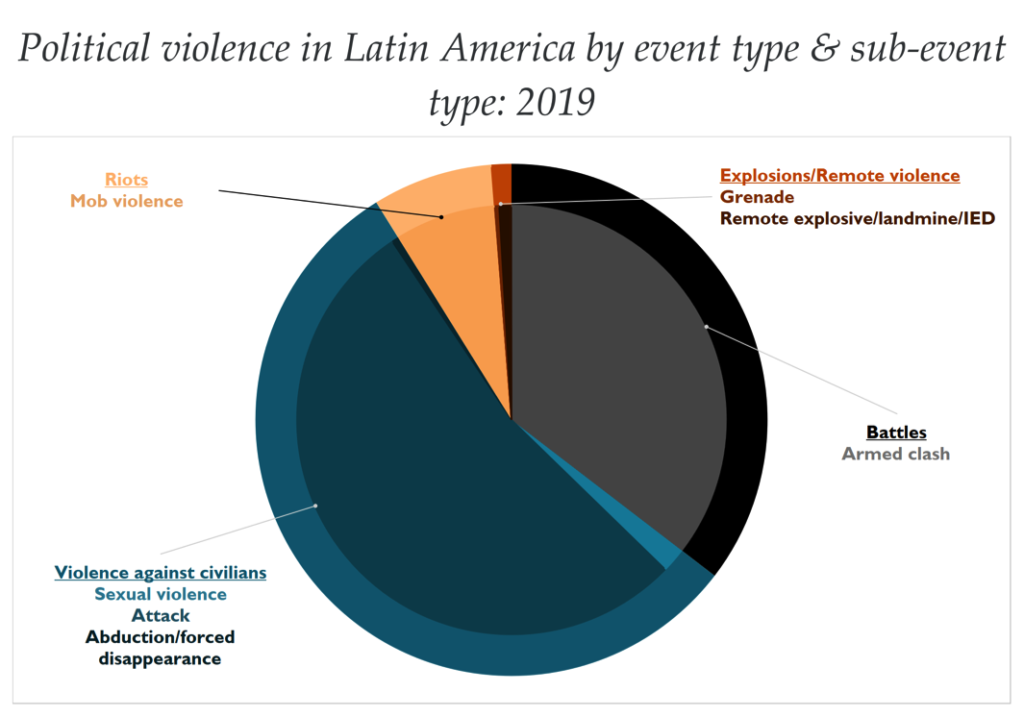27 February 2020: The Armed Conflict Location & Event Data Project (ACLED) has now expanded real-time coverage to Latin America and the Caribbean. These new data span more than 40 countries and territories, adding over 40,000 political violence and protest events to the ACLED dataset from the beginning of 2019 to the present.
Access the press release in Spanish or as a PDF.
Political Violence and Protest in Latin America: 2019
- ACLED records more than 40,000 disorder events in the region
- Over 19,400 are political violence events1
- More than 11,500 are civilian targeting events
- Over half of these are reported in Mexico and nearly one-fifth in Brazil
- More than 11,500 are civilian targeting events
- Over 19,500 are demonstration events2
- Over four-fifths are peaceful protests without intervention, mainly recorded in Mexico, Brazil, Venezuela, Argentina, and Chile
- Over 19,400 are political violence events1
- ACLED records over 19,000 reported fatalities stemming from disorder last year
- Approximately half are reported in Mexico and one quarter in Brazil
- Nearly a third stem from battles between state forces and non-state armed groups, including gangs, as well as clashes between non-state armed groups
- Civilians in Latin America face high levels of political violence, accounting for at least two-thirds of all fatalities reported across the region in 2019
- More than half of all civilian fatalities are recorded in Mexico and nearly a fifth in Brazil
- The primary perpetrators of violence targeting civilians are anonymous or unidentified armed groups, as well as anonymous or unidentified criminal gangs.3 Together, these groups are responsible for over half of all civilian fatalities
In Focus: Protest Movements
2019 was a year of intense civil unrest in Latin America. ACLED records high levels of demonstration activity across the region, with events reported in nearly every country. From Mexico and Bolivia to Chile and Venezuela, demonstrators protested over a range of issues, including corruption, austerity measures, and economic inequality. Although some governments offered concessions, as in Chile, most either ignored or suppressed the protests.
- ACLED records more than 19,500 demonstration events across 41 countries and territories
- The countries with the highest numbers of demonstrations include:
- Mexico – over 5,100 events (0.398 events per 10,000 people)
- Brazil – over 3,500 events (0.171 events per 10,000 people)
- Venezuela – over 2,500 events (0.776 events per 10,000 people)
- Chile – over 2,000 events (1.002 events per 10,000 people)
- Argentina – over 1,100 events (0.267 events per 10,000 people)
- When controlling for population size, these figures particularly underscore the scale of the social movements in Chile and Venezuela
- The countries with the highest numbers of demonstrations include:
- More than four-fifths of all demonstration events are peaceful protests4
- In approximately 4% of all events, peaceful protesters are met with intervention, ranging from arrests to lethal violence
- State forces are the primary perpetrators of such intervention
- Nearly a quarter of these events are reported in Chile, and nearly a fifth in Venezuela
- Fewer than 1% of all events specifically involve the use of excessive force against peaceful protesters.5 Almost half of these events are reported in Venezuela, and a fifth in Chile
- Demonstrations are linked to over 140 fatalities, primarily in Venezuela and Haiti
- Two-fifths of these fatalities are reported in Venezuela, stemming from excessive force against peaceful protesters, primarily by state forces
- A quarter of these fatalities are reported in Haiti, stemming almost entirely from violent demonstrations in which rioters clashed with state forces
In Focus: Gang Violence
Armed gangs are major actors shaping the political violence landscape in Latin America and the Caribbean. They engage in illicit economic activity, challenge the state’s monopoly on violence, and even offer social services for a price. As ACLED’s mandate is limited to political violence, gang activity is only recorded when such groups use violence to achieve overt political goals and/or directly and fundamentally challenge public safety and security. Gang violence that is purely criminal in nature falls outside of ACLED’s ambit.6
- ACLED records over 170 distinct gang actors across the region, though four-fifths of all gang violence is attributed to anonymous or unidentified armed groups that exhibit gang tactics, techniques, and procedures of violence
- Mexico is home to half of these gangs7
- The most active identified gangs are:
- CV: Red Command, active in Brazil (268 events, resulting in 263 reported fatalities)
- MS-13: Mara Salvatrucha, active primarily in El Salvador, as well as Honduras, Guatemala, Mexico, and Costa Rica (202 events, resulting in 283 reported fatalities)
- TCP: Pure Third Command, active in Brazil (148 events, resulting in 135 reported fatalities)
- CJNG: Jalisco New Generation Cartel, active in Mexico (136 events, resulting in 257 reported fatalities)
- B-18: Barrio-18, active primarily in El Salvador, as well as Honduras and Guatemala (111 events, resulting in 159 reported fatalities)
- Of named gangs, those responsible for the most civilian fatalities are:
- CJNG: 85 civilian fatalities
- MS-13: 77 civilian fatalities
- B-18: 25 civilian fatalities
- CV: 18 civilian fatalities
- North-East Cartel, active in Mexico: 15 civilian fatalities
- Together, these identified gang actors are responsible for over 4,100 political violence events targeting civilians — or at least a third of all political violence targeting civilians recorded throughout the region in 2019 — resulting in at least 5,300 reported fatalities
- Nearly two-thirds of all gang activity occurs in Mexico and over one quarter occurs in Brazil
- Violence targeting civilians makes up over half of all gang activity
- Nearly half of all civilian targeting by gangs is reported in Mexico. Though at least 27 distinct, named gangs are active in Mexico, over 97% of civilian targeting by gangs is carried out by anonymous or unidentified groups
- Battles with state forces or other gangs account for nearly a third of all gang activity
- Over half of these events occur in Brazil, a quarter in Mexico, and over 13% in El Salvador
A US-based 501(c)(3) non-profit organization established in 2014, ACLED is the highest quality and most widely used real-time data and analysis source on political violence and protest around the world.
If you would like to use ACLED analysis or visuals, please review our Terms of Use and Attribution Policy.
Find more information about ACLED methodology and coding decisions around political violence and protest activity in Latin America and the Caribbean here.
For interview requests and press inquiries, please contact:
Sam Jones
Communications Manager, [email protected]
___________
Download a PDF of this press release here.
___________
1 This includes the following ACLED event and sub-event types: Battles, Explosions/Remote violence, Violence against civilians, and the Mob violence sub-event type of Riots.
2 This includes the following ACLED event types: Protests and Riots, with the exception of the Mob violence sub-event type.
3 For more information about how ACLED codes gang activity, see this methodology brief.
4 This means that there were no reports of demonstrators engaging in violence or vandalism.
5 These events are a subset of events in which peaceful protesters are met with some sort of intervention.
6 As such, gang violence is only recorded in Belize, Brazil, El Salvador, Guatemala, Haiti, Honduras, Jamaica, Mexico, Puerto Rico, and Trinidad and Tobago; in other countries/territories, similar violence is assumed to be purely criminal, and therefore beyond ACLED’s mandate.
7 For more information about how ACLED codes gang activity, see this methodology brief.








